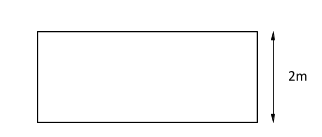
What is the maximum possible area of a parallelogram with one side of length 2 meters and a perimeter of 24 meters ?
A.40 m2
B.22 m2
C.25 m2
D.20 m2
Answer
565.8k+ views
Hint: To answer this type of problem we will just try to evaluate the maximum length of the parallelogram when one of the sides is already given as 2m. Once we will find the maximum length of the parallelogram using the given value of perimeter of the parallelogram. Then we will multiply both length and breath such that we will be able to find the maximum area of the parallelogram.
Complete step-by-step answer:
Given that one of the side lengths of the parallelogram is 2 m and the perimeter of the parallelogram is 24 m.
As shown in parallelogram figure below

So,
If one side of the parallelogram is 2 meters long, then the opposite side must also be 2 meters long.
Now suppose the length of the unknown side is x.
You can solve for the unknown sides, which are equal in length, by writing an equation for the perimeter: \[24 = 2\left( 2 \right) + 2x\] , with x as the unknown side.
Solving, you get \[x = 10\;\]m.
The parallelogram with these dimensions and maximum area is a rectangle with 2 metres and 10 metres sides.
Thus, the maximum possible area of the parallelogram is: \[2 \times 10\; = 20\]m2.
It is given in option D that maximum possible area of the parallelogram is \[20\]m2
So, the correct answer is “Option D”.
Note: We can use this concept only for square rectangle, parallelogram and rhombus. We can not use it for all the types of quadrilateral because the square rectangle, parallelogram and rhombus length of opposite sides are the same.
Complete step-by-step answer:
Given that one of the side lengths of the parallelogram is 2 m and the perimeter of the parallelogram is 24 m.
As shown in parallelogram figure below

So,
If one side of the parallelogram is 2 meters long, then the opposite side must also be 2 meters long.
Now suppose the length of the unknown side is x.
You can solve for the unknown sides, which are equal in length, by writing an equation for the perimeter: \[24 = 2\left( 2 \right) + 2x\] , with x as the unknown side.
Solving, you get \[x = 10\;\]m.
The parallelogram with these dimensions and maximum area is a rectangle with 2 metres and 10 metres sides.
Thus, the maximum possible area of the parallelogram is: \[2 \times 10\; = 20\]m2.
It is given in option D that maximum possible area of the parallelogram is \[20\]m2
So, the correct answer is “Option D”.
Note: We can use this concept only for square rectangle, parallelogram and rhombus. We can not use it for all the types of quadrilateral because the square rectangle, parallelogram and rhombus length of opposite sides are the same.
Recently Updated Pages
Master Class 9 Social Science: Engaging Questions & Answers for Success

Master Class 9 Science: Engaging Questions & Answers for Success

Master Class 9 English: Engaging Questions & Answers for Success

Master Class 9 Maths: Engaging Questions & Answers for Success

Master Class 9 General Knowledge: Engaging Questions & Answers for Success

Class 9 Question and Answer - Your Ultimate Solutions Guide

Trending doubts
Which places in India experience sunrise first and class 9 social science CBSE

Fill the blanks with the suitable prepositions 1 The class 9 english CBSE

Write the 6 fundamental rights of India and explain in detail

Difference Between Plant Cell and Animal Cell

What is pollution? How many types of pollution? Define it

What is the Full Form of ISI and RAW





